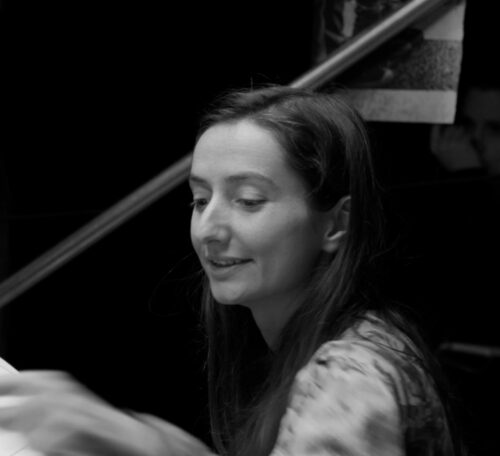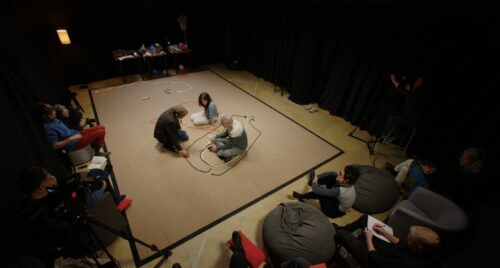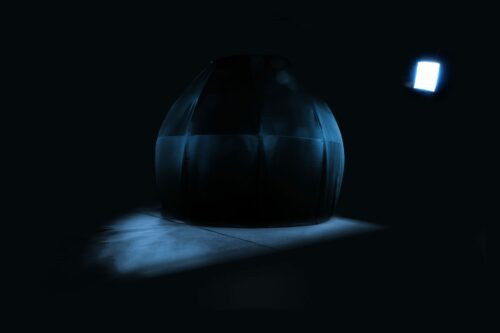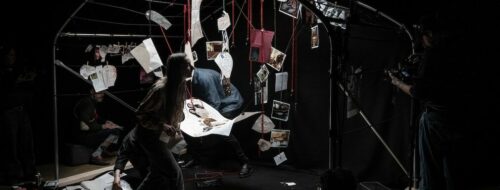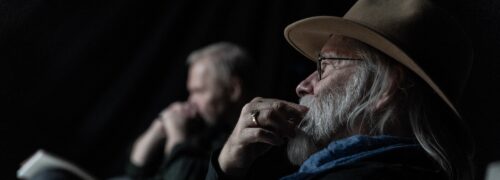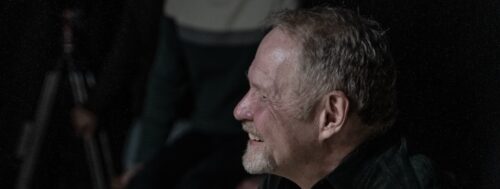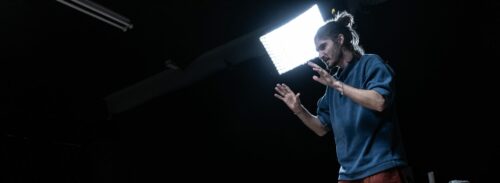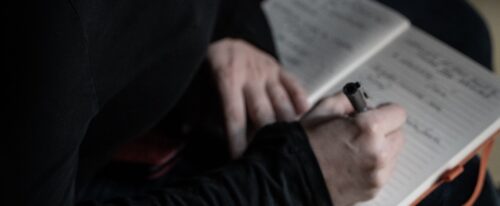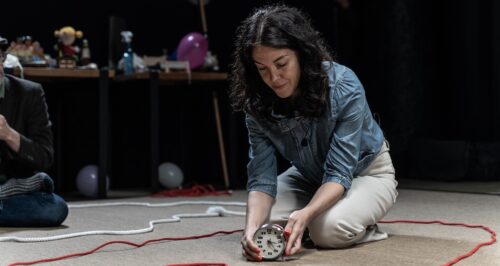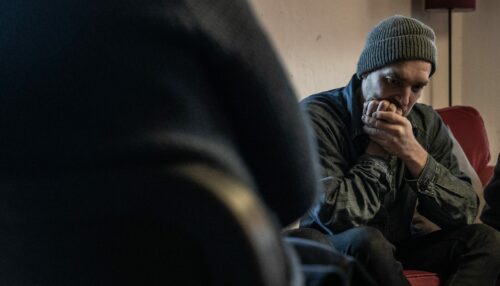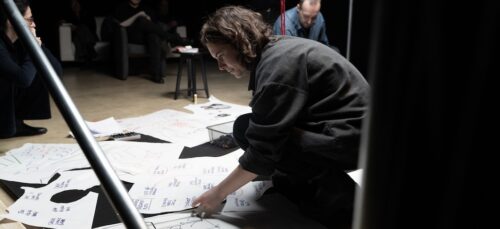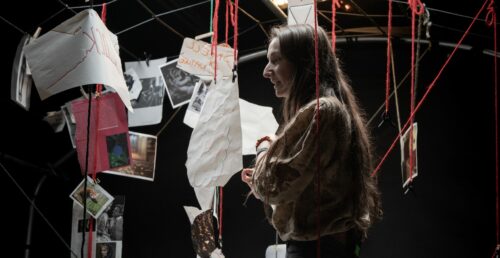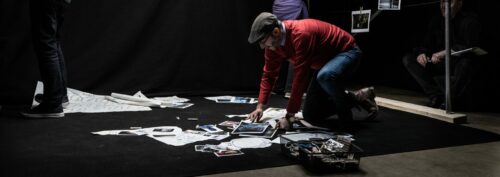Violette Garcia
A graduate of FEMIS in screenwriting (2019), Violette Garcia contributed to the writing of Pierre Schoeller’s upcoming feature film, “Rembrandt,” with Anne-Louise Trividic and Pierre Schoeller, and co-wrote Fabienne Berthaud’s next film, “Sauvagines.” She also collaborated on the writing of Davy Chou’s “Retour à Séoul” and co-wrote “Homo Animalis,” a wildlife documentary by Jacques Mitsch about human beings. She is also developing personal projects, including a short film created within the War on Screen Talent Lab in Châlons-en-Champagne, “MQ-9 Reaper, others may die.” After completing a master’s degree in geography, she worked at the French research center in Jerusalem. She has also written documentaries for directors, mainly for ARTE. While her curiosity for reality, geopolitics, and current affairs is genuine, it is made possible and balanced by her love for genre films, comedy, and thrillers, without renouncing the fantastical.
— As part of its 5th season, the StoryTANK team wanted to try a new experiment, under the guidance of six passionate and captivating researchers. The goal was to test and film the emergence of story ideas within experimental frameworks created by LA FABRIQUE DES MONDES — a unique initiative in Europe, developed at Le Groupe Ouest since 2023, under the auspices of the French Ministry of Culture.
The experience was offered to six screenwriters or filmmakers from six different European countries. Here, the StoryTANK provides an opportunity to explore and shed light on the creative process.
Below, a debrief by Violette Garcia, as she reflects on her experience.
BRING THE CHARACTERS TO LIFE TO BRING THE STORY TO LIFE
“If we want to (d)escribe characters, we must embody them.”
If we want to (d)escribe characters, we must embody them. Embodiment can open up so many possibilities, through the rich experimentation of the character’s characteristics.
THE CAVE
A COMPLETE IMMERSION IN THE NARRATIVE COMPOSITION
“ The Cave even transforms the way we think, through our bodies: which is essential in the writing process.”
Starting with a film idea, a small seed in the order of a scene, an image, or a situation, the Cave perfectly fulfills its role as a possible space for complete immersion in that image or situation. We immediately started getting up, bending down, moving around: everything obviously became much more organic and alive. How can we think through our bodies? For me, it’s quite essential in the writing process.
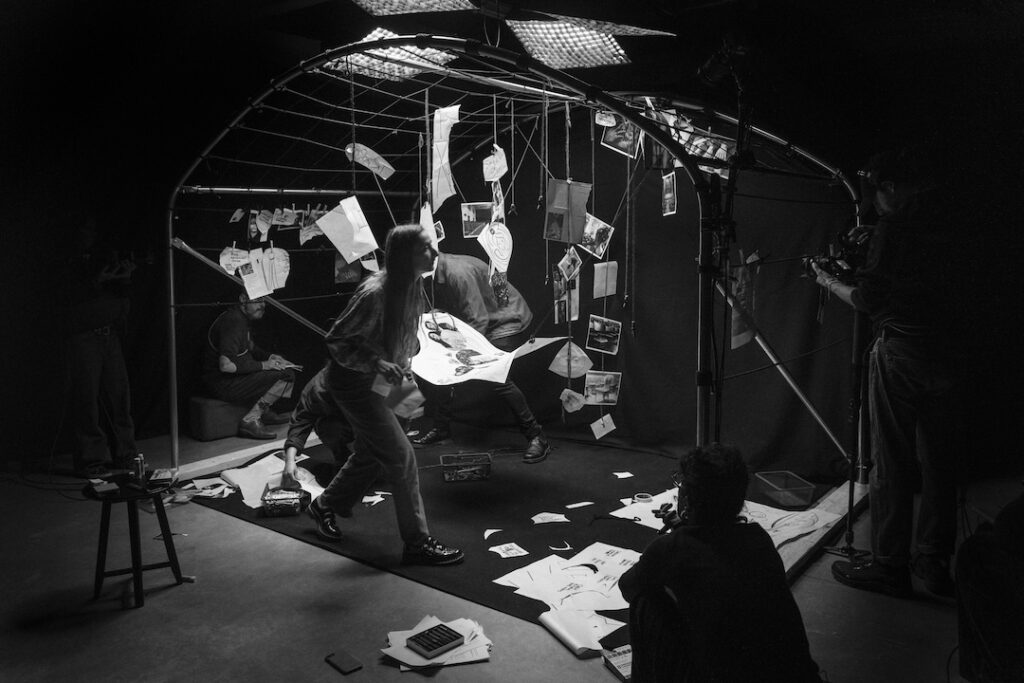
THE COLLABORATIVE AND SHARED WRITING PROCESS
“In the Cave, we are never blocked or crushed by a wall.”
I often suffer from sitting, from being static, or from being faced solely with a wall or a painting. It can be very interesting at certain moments in the development of a film, but it can also be completely overwhelming. When you’re facing a wall, you’re there, motionless, as if something could just fall on you, but you have no solution. In the Cave, you can enter it, leave it, add things, you can wander around. We’re never blocked or crushed by a wall: the development of the story very quickly becomes collaborative and shared.
THE MULTITUDE AND PLASTICITY OF IMAGINARIES
“In the Cave, we spatialize the narrative: we bump into it!”
The Cave orchestrates a dynamic of horizontality, which allows us to share things, to listen to each other better, together, on an equal footing. The Cave generates a multitude of imaginaries by spatializing our thoughts, without us feeling that things are fixed, once and for all, or that there is a right or wrong way of doing things, since we can always come back, pick something up there, put it somewhere else. Breathing is located in the bodies, and also in the images and words, the paper, the tools, and everything we handle. A powerful moment in the Cave is when we stand and hang up all the materials initially placed on the ground. We wander, then, between the characters, we start to suspend these things, we then spatialize the story: we bump into it!
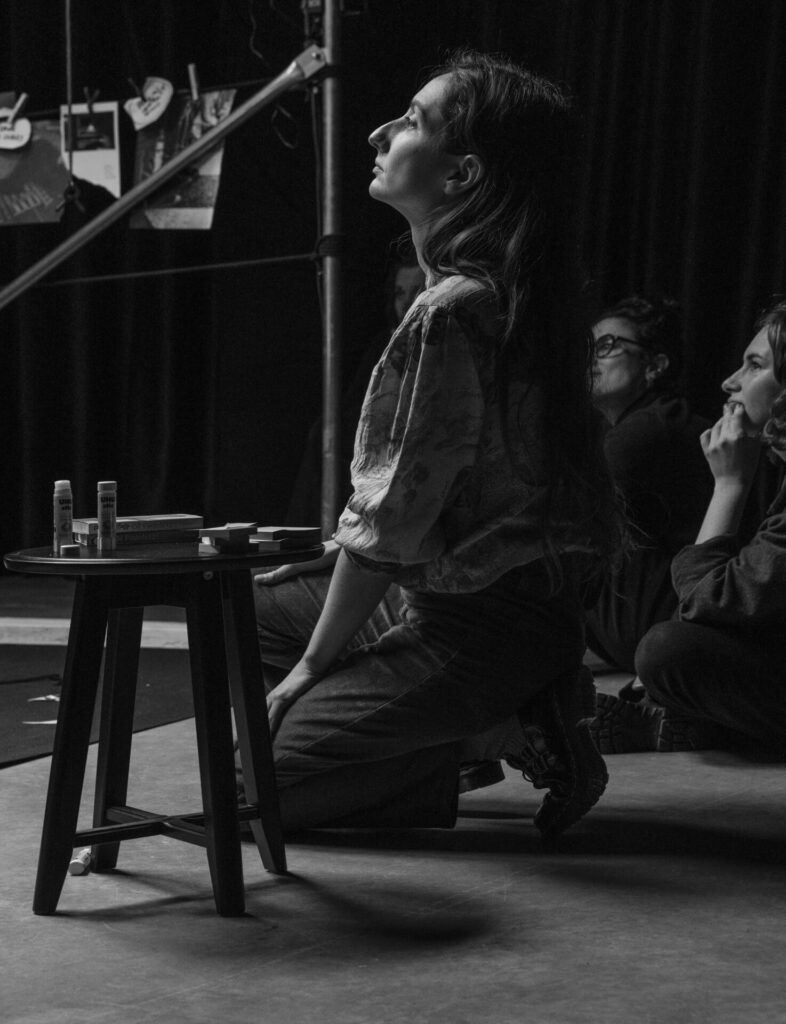
THE BLACK ROOM
SUBMERSION BY EMOTION FOR THE PROJECTION OF THE STORY
“In the Black Room, we find the characters!”
In the Black Room, we find the characters. Sound and emotion allow for an organic search, particularly in the identification of characters, through the imagination of what we project onto the sounds we hear. We inevitably project people, sounds, either in the first person or because we imagine a character. There’s a kind of letting go possible when we’re in the dark. It’s a place where the body is there, but as if at rest: we can forget it and let the mind or emotion emerge. The Black Room works at the heart of our unconscious, investigating the more animal, organic, and profound components of the story that are within us.
A PROTOCOL, A SPECIFIC QUEST TO OPEN THE STORY
“ The Black Room puts us in a state of meditation, of trance, a kind of altered state that drives us a little crazy.”
I suddenly enter the Black Room and, in a second, I’m curled up, touching my forehead in a regressive, fetal movement, like a big, strange baby. It’s a little strange, but it’s a good way to be both completely within myself and, at the same time, to fully feel the others around me. The experience is very intense because it’s “agitated”. Starting with the protocol that leads us to know what we’re looking for there precisely, the Black Room plunges us into a state of meditation, of trance, a kind of altered state that drives us a little crazy.
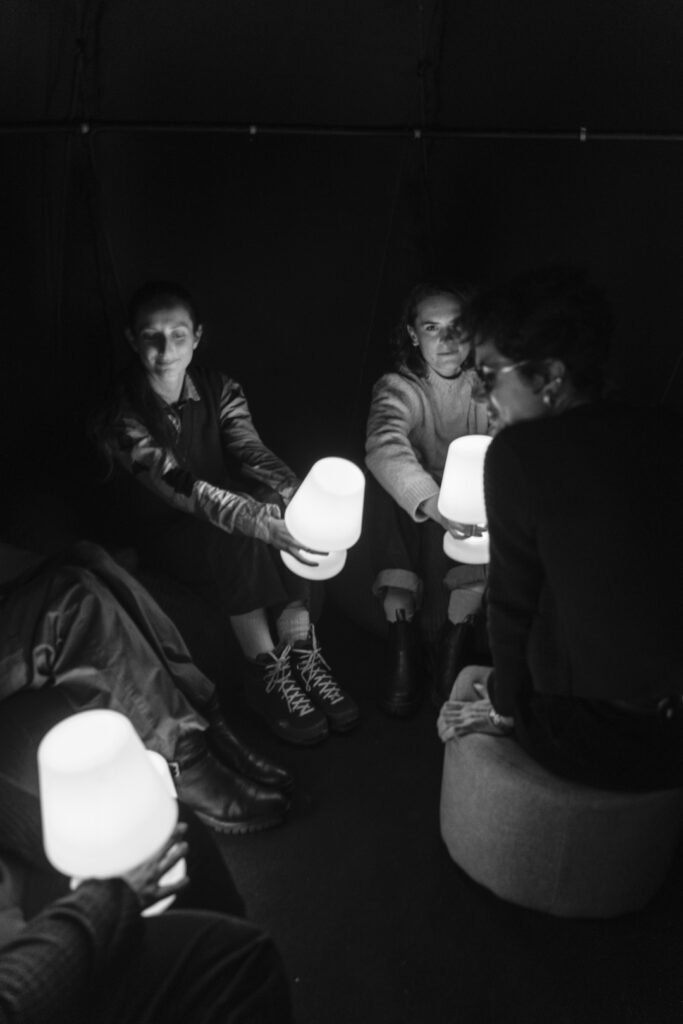
NOURISHING THE COMPOSITION OF THE STORY THROUGH SOUND
“Experimenting with sound, through the creation of a free and exploratory soundtrack, allows us to come together and connect.”
With the Black Room, experimenting with sound, through the creation of a free and spontaneous soundtrack, allows us to come together and connect. A collective sonic imprint at a specific moment in the composition of the story that allows us to delve deeper, quite subliminally.
INTIMATE AND SHARED LISTENING TO THE POTENTIAL OF THE STORY
“In the Black Room, we have a character in mind and we become that character, precisely”
In the Black Room, the experience is more intimate. Thanks to attentive listening in the dark, the mind is overwhelmed by emotion and wanders, as part of a conscious reflection on the potential of the story. We have a character in mind and we become that character, precisely. We feel the same strength emanating from our co-authors with whom we began the experience, from the Cave. We are both under collective control and, in a state of trust, fully experiencing this state of creation.
THE PLATEAU
THE NARRATIVE IS LIKE A LARGE LIVING TABLEAU TO EXPERIENCE AND EXPLORE
“ The Plateau allows us to visualize and connect the characters, spatializing them within the narrative timeframe.”
In the Cave, we are at the stage of paper manipulation, of somewhat conceptual things. On the Plateau, we move on to embodiment, with the selection of objects by individuals and in trios, then involving contributors to embody these characters. By placing the objects and the witness-figures in space and connecting them with cords to see the connections, the Plateau allows us to visualize the characters and spatialize them within the narrative timeframe, establishing their positions in the present, past, or future of the narrative: a large living tableau to explore and unfold!
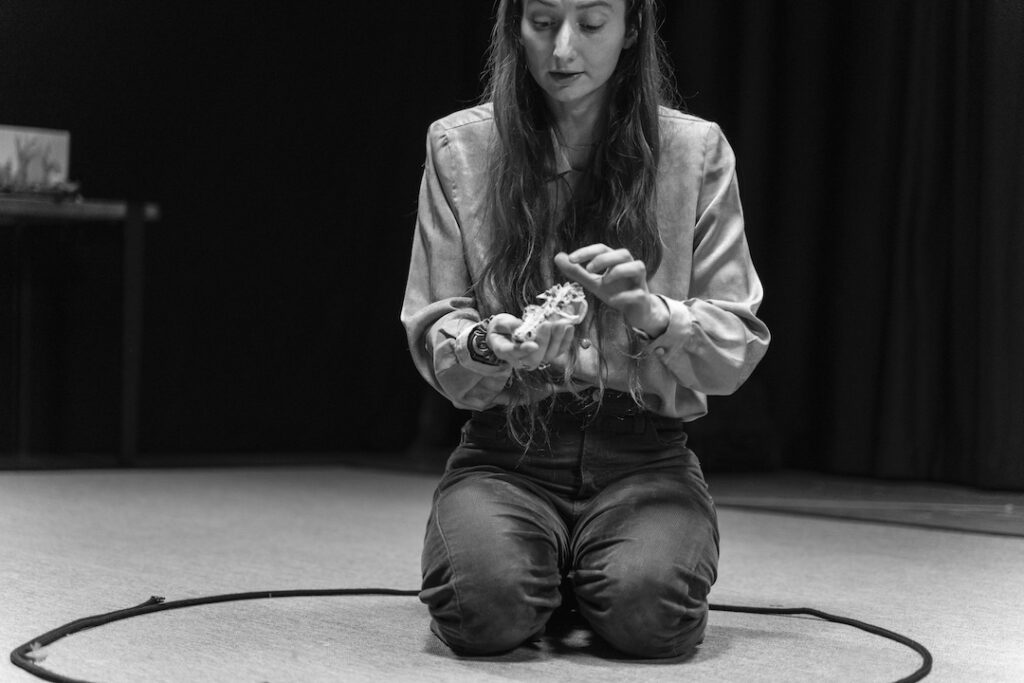
STORYTELLING THROUGH MOVEMENT
“On the Plateau, we build a world live, together”
On the Plateau, we quickly manage to connect, as three minds, with this rare feeling of truly developing an imagination, together: building a world live, together. Within the Plateau, we overcome this kind of modesty or barrier that prevents us from externalizing and therefore embodying. By exploring with the body, the story becomes much more spontaneous, freer, more organic. The collective imagination is ultra-stimulated when we are in movement and when we perform. The Plateau has this playful approach, essential to this precise phase of storytelling research.
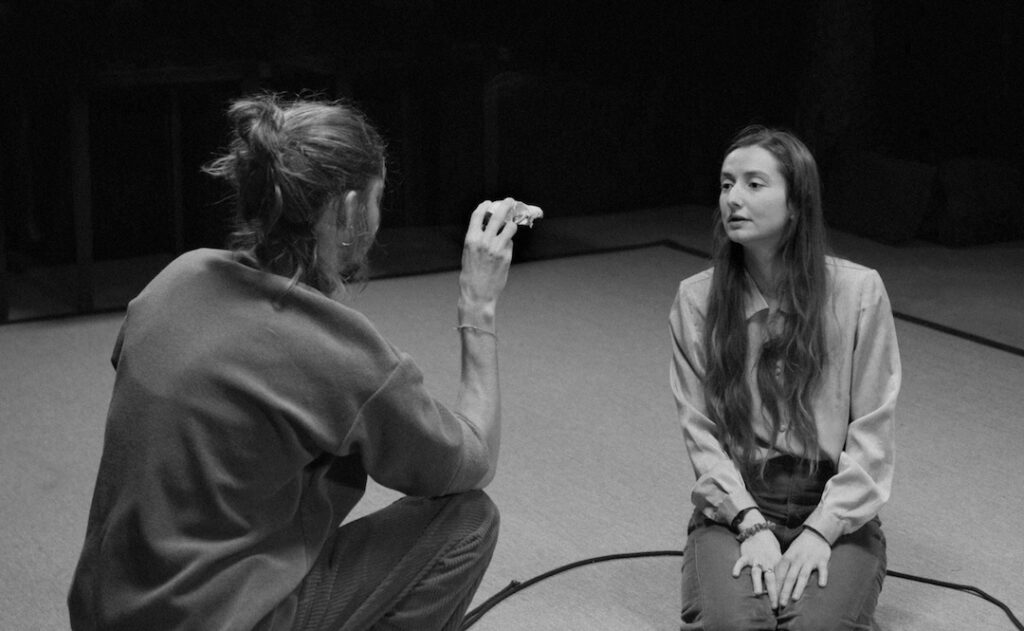
THE FACTORY WORLD
BEING AVAILABLE FOR STORY GENERATION
“It was a truly joyful and playful moment of exploration.”
The various experimental devices in THE FACTORY OF WORLDS create a truly joyful moment, a moment of play, first and foremost because I am completely available for that moment. We are all in this very joyful and playful state of mind: we are ready to explore what will be generated.
THE GERMINATION OF THE STORY, STEP BY STEP
“ The little seed planted in the Cave germinates in the Black Room, then, on the Plateau, we find the embodiment and therefore the possibility of a film.”
The little seed planted in the Cave germinates in the Black Room. It becomes a character and, above all, emotion, without knowing exactly where to settle, but by being very present and alive. And on the Plateau, we find the embodiment and therefore the possibility of a film, because it’s the place where the components of the story can unfold.

WORKING ON A STORY AS A SERIES OF PHYSICAL EXPERIENCES
“It’s very rare to have the opportunity to work on a story with the body.”
It’s very rare to have the opportunity to work on a story, within the framework of these experimental programs, particularly with the body. We rarely have the opportunity to have a dedicated space, and especially dedicated time. In my work as a screenwriter, I’m not given the opportunity to have a Black Room if I want to, nor to practice object theater, even though both would help me embody an idea in a tableau vivant from the very beginning. THE FACTORY OF WORLDS helps us first tell the story internally and to collectively develop all the milestones of the story that will become the essential hooks for the film or series we will then develop.
